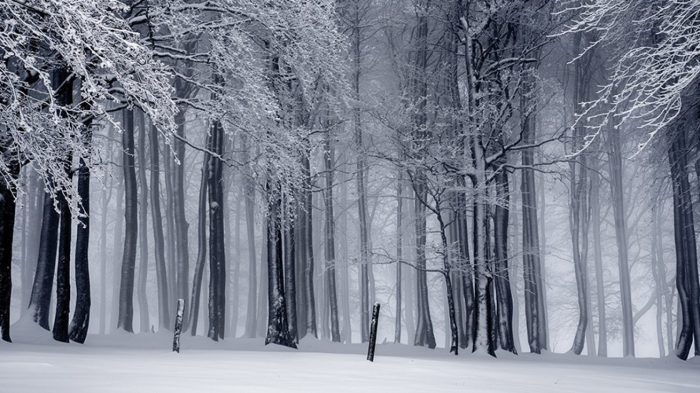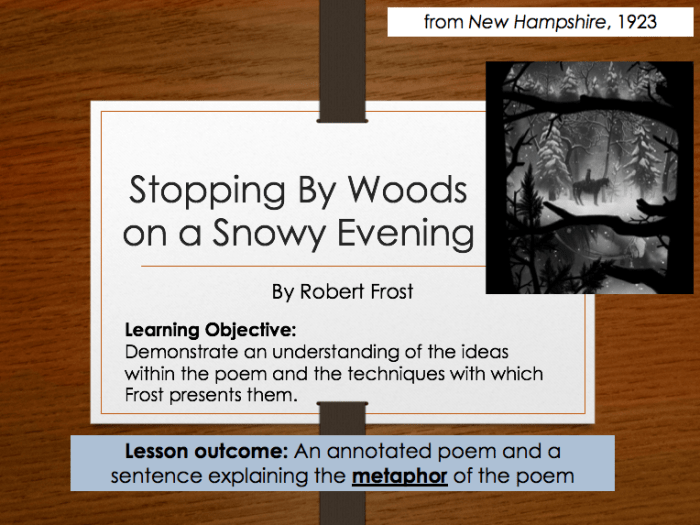Figurative language in stopping by woods on a snowy evening – Figurative language is a powerful tool that poets use to create vivid imagery, evoke emotions, and convey complex ideas. In “Stopping by Woods on a Snowy Evening,” Robert Frost employs a rich tapestry of figurative language to explore themes of nature, solitude, and the human condition.
Through the use of metaphors, similes, personification, and symbolism, Frost paints a vivid picture of a winter landscape and the speaker’s contemplation of his own mortality. The poem’s imagery and symbolism work together to create a sense of both beauty and unease, leaving the reader with a lingering sense of wonder and reflection.
Figurative Language in “Stopping by Woods on a Snowy Evening”

Robert Frost’s “Stopping by Woods on a Snowy Evening” is a classic poem that employs various literary devices, including imagery, symbolism, personification, and metaphors. These elements enhance the poem’s atmosphere, mood, and meaning, creating a profound and evocative experience for the reader.
Imagery in “Stopping by Woods on a Snowy Evening”, Figurative language in stopping by woods on a snowy evening
Frost’s use of vivid imagery creates a sensory experience for the reader. The poem’s opening line, “Whose woods these are I think I know,” immediately establishes a sense of place and time. The description of the “dark and deep” woods, the “easy wind and downy flake,” and the “snow-filled lonely fields” evokes a serene and isolated winter landscape.
The imagery also contributes to the poem’s atmosphere and mood. The dark woods and falling snow suggest a sense of mystery and wonder, while the lonely fields and the sound of the wind create a feeling of solitude and contemplation.
Symbolism in “Stopping by Woods on a Snowy Evening”
The poem’s imagery also carries symbolic meaning. The woods represent the unknown and the mysterious, a place where the speaker can escape the demands of the world. The snow symbolizes purity and renewal, but also the cold and harshness of nature.
The horse represents the speaker’s responsibilities and obligations. The speaker’s decision to “stop by” the woods but ultimately continue his journey suggests a conflict between his desire for solitude and contemplation and his need to fulfill his duties.
Personification in “Stopping by Woods on a Snowy Evening”
Frost also uses personification to create a sense of connection between the speaker and the natural world. The woods are described as “easy” and the snow as “downy,” suggesting that they are gentle and inviting.
The horse is also personified as having “promises to keep.” This gives the horse a sense of agency and suggests that the speaker’s obligations are not merely external but also internalized.
Figurative Language in “Stopping by Woods on a Snowy Evening”
The poem’s use of imagery, symbolism, and personification work together to create a rich and nuanced tapestry of meaning. These elements enhance the poem’s emotional impact and allow the reader to experience the speaker’s inner thoughts and feelings.
Frost’s masterful use of figurative language makes “Stopping by Woods on a Snowy Evening” a timeless classic that continues to resonate with readers today.
Query Resolution: Figurative Language In Stopping By Woods On A Snowy Evening
What is the significance of the woods in the poem?
The woods represent both a physical and metaphorical space. They are a place of beauty and solitude, but they also symbolize the unknown and the potential for danger.
How does the use of personification contribute to the poem’s meaning?
Personification gives human qualities to non-human things, such as the horse and the woods. This technique helps to create a sense of connection between the speaker and the natural world, and it also suggests that the natural world is alive and responsive.
What is the central theme of the poem?
The central theme of the poem is the tension between the speaker’s desire for solitude and his awareness of the inevitability of death. The poem explores the human need for connection and meaning in the face of mortality.

